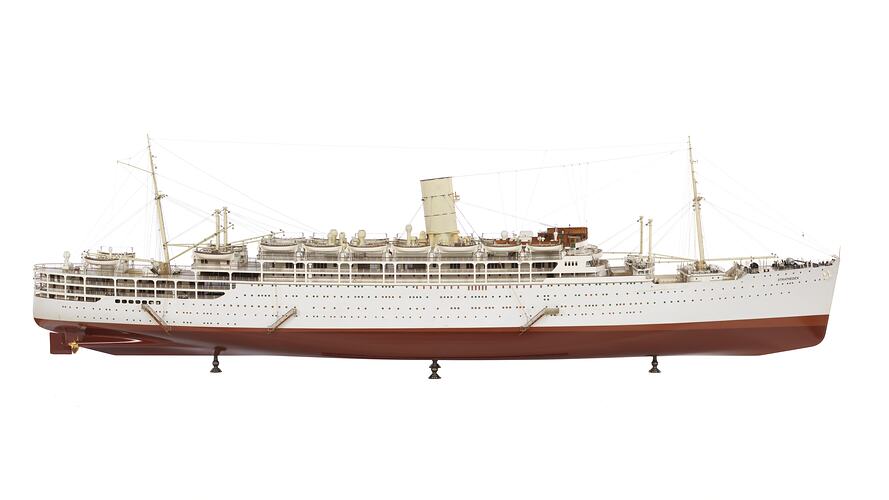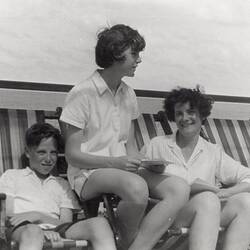Summary
Shipbuilder' s scale model of the P&O Line's Royal Mail, passenger & cargo liner S.S. 'Stratheden', mounted in original glass and wooden display case. The model scale appears to be 1:54 or 1-inch to 4½ feet.
Launched by the Duchess of Buccleuch and Queensberry from the Vickers-Armstrong Limited shipyard at Barrow-in-Furness, on 10th June 1937, the S.S. Stratheden, was the fifth of five sister ships in the Peninsular & Oriental Steam Navigation Company's famous series of white 'Strath' sister ships which transformed that company's premium service on the England to Australia route during the 1930s. Registered at 23,732 tons gross, the ship was powered by twin screws driven by six single-reduction geared Parsons steam turbines providing a rated power output of 28,000 horsepower and a service speed of 21 knots.
Originally fitted out for both long ocean voyages and cruising, the ship was initially given accommodation for 448 first-class berths in 216 single and 116 two-berth cabins, many of which featured private bathrooms. There were also two luxurious vice-regal suites, comprising a private dining room, sitting room, verandah, bedroom and bathroom, and six cabins-de-luxe. Accommodation for was also provided for 663 tourist passengers (equivalent to the earlier third class) in 233 shared cabins on the lowest three decks. Other features for the benefit of passengers included full air-conditioning in the first class dining saloon and mechanical ventilation throughout, while all first-class cabins were equipped with a telephone service, operated through a switchboard, with additional phones in public spaces. A crew of 563 was carried, including 340 stewards. In keeping with other passenger liners of the period, the ship was also equipped with extensive cargo holds - three forward offering refrigerated space for Australian exports such as apples, frozen meat and dairy produce, and three aft for general cargo, including motor cars.
The Stratheden, departed Tilbury Docks, London, for her maiden voyage to Australia on 24 December 1937, under Captain R. Harrison, carrying over 600 passengers and 8,513 bags of mail, arriving in Melbourne on 31st January and in Sydney on 3rd February, 1938. The route typically followed during the ship's early years was Tilbury, Gibraltar, Marseilles (homeward voyages only), Port Said, Aden, Bombay, Colombo, Fremantle, Adelaide and Melbourne before terminating in Sydney. On its maiden voyage the ship also included visits to Hobart and Brisbane, and from January 1939, the Stratheden, pioneered an extension of the usual P&O route to incorporate a round trip to New Zealand ports from Sydney before the return voyage to London, giving Australian passengers the chance of a trans-Tasman cruise. When war broke out in September 1939, the Stratheden was on her way out to Australia and became the first British liner to pass through the perilous Atlantic and Mediterranean German submarine zones. On her return to Britain, she was requisitioned for troop transport and hurriedly refitted with accommodation for 1,500 military personal, with all her luxurious peacetime fittings being stripped out and placed in storage. During her wartime service as a troop ship, she carried 149,687 servicemen and civilians and steamed nearly half a million miles. Her four sister ships also served with distinction as troop ships during the War, and all but one survived unscathed. The Strathallan, was torpedoed by the German U-Boat 562 off the Algerian Coast of North Africa on 21st December 1942, and sunk the following day.
After the War, the Stratheden was the first P&O Liner to return to the regular Australian service, departing Tilbury in June 1947 for her maiden post-World War II voyage, after an extensive refit at Vickers-Armstrong's yards. As refitted after the War she had accommodation for 527 first-class and 453 tourist-class passengers. Over the next fifteen years the ship regularly worked on the Australian route, with only a brief break in 1950, to undertake a four voyage trans-Atlantic charter to the Cunard Line. In 1961, after the oldest two Strath liners were withdrawn, the Stratheden and Strathaird were converted to single-class ships, with accommodation for 1,200 passengers each. In this capacity she was primarily used for assisted immigrant voyages, but two years later declining demand saw the two vessels withdrawn, with Stratheden departing Tilbury for her final voyage to Australia on 20th June 1963, and Sydney for the last time on 29th July, followed by Fremantle, on 7th August. The Stratheden had made a total of 52 voyages to Australia - more than other P&O Liner in the post-World War I era and carried many thousands of English, Scottish and European migrants to Australia during the 1940s, 50s and 60s, in addition to many government and business passengers and tourists.
Set new standards of passenger comfort and interior design elegance on the P&O Line's flagship England-Australia route during the art deco era of the 1930s.
Physical Description
Solid wooden-hulled ship model with laminated planked decking and miniaturised metal, wood and glass fittings and full deck furnishings and rigging. There appears to have been no plastics used in the model's construction. The model is mounted in its original oak-framed display case with shout turned legs and glazing all-round on four sides and overhead. Model length 4.1 metres (148-in) x width 0.8 metres (16-in) x height 2.2 metres (42-in) (including original display case) The height of the plinth is about 0.9 metres (36-in) above floor level The dimensions of the original ship were: Length overall 664 ft 6 in (202.54 m) Breath moulded 82 ft 0 in (24.99 m) Depth to 'C' deck 63 ft 6 in (19.35 m) Draught 30 ft (9.1 m) Model scale appears to be 1:54 or 1 inch to 4½ feet.
More Information
-
Collecting Areas
-
Acquisition Information
Purchase
-
Ship Depicted
SS Stratheden (Steamship), P & O Line, London, England, Great Britain, circa 1938
-
Commissioned By
-
Commissioned By
Peninsular & Oriental Steam Navigation Co. (P&O Line), circa 1938
-
Brand Names
-
Classification
-
Category
-
Discipline
-
Type of item
-
Exhibition Collection Management
4180 mm (Length), 1100 mm (Width), 2200 mm (Height)
-
Approximate Dimensions
3740 mm (Length), 500 mm (Width), 1080 mm (Height)
Estimate of model only. Taken through glass.
-
Conservation
3760 mm (Length), 500 mm (Width), 1040 mm (Height)
Approx dimensions taken through glass of ship model only. Stands/mounts measure approx 70mm high, so total display height is 1110mm
-
Conservation
1105 mm (Height)
Height of model including stands.
-
Object Measurements
220 kg (Weight)
Weight of stillage = 164kg
-
Model Scale
1:48
-
Keywords

